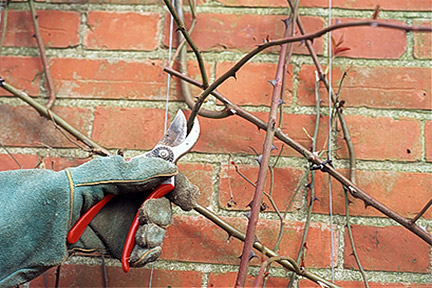Rose pruning: climbing roses
Rose pruning ensures that plants grow vigorously and flower well each year. If left, climbing roses can become a tangled mess of branches with very few flowers. Although often considered complicated, rose pruning is not difficult if you follow this guide.
RHS
4/9/20242 min read
When to do it
Climbers are routinely pruned in winter, after the flowers have faded, between December and February. Long whippy shoots can be shortened or tied in during autumn, to prevent strong winds from damaging them.
Renovation can be carried out at any time between late autumn and late winter. It is easier to see what you are doing when the rose is not in leaf, plus there is a better response from the rose, which should grow back vigorously the following spring.
How to prune climbing roses
Formative training and pruning of young climbing roses
Climbing roses are not self-clinging and need supports of trellis or horizontal wires to which the shoots can be tied.
Set the lowest wire 45cm (18in) off the ground and space subsequent wires 30cm (1ft) apart
If training roses up pillars, arches or pergolas, twist the main shoots gently around the uprights, keeping them as horizontal as possible, to encourage flowering shoots to form low down
If the main stems are slow to branch, tip-prune them to the first strong bud to encourage side shoots, otherwise leave them to fill the available space
Remove dead, damaged, diseased or spindly growth, and deadhead during the flowering season to encourage further flowering
Routine pruning of climbing roses
First remove dead, diseased or dying branches
Then tie in any new shoots needed to fill supports
Prune any flowered side shoots back by two thirds of their length
If the plant is heavily congested, cut out any really old branches from the base to promote new growth
Renovating overgrown climbing roses
Remove all dead, diseased, dying and weak shoots
Cut some of the old woody branches to the ground, retaining a maximum of six young, vigorous stems that can be secured to supports
Saw away any dead stumps at the base of the plant, where rain can collect and encourage rot
Shorten side shoots on the remaining branches and prune back the tips by one third to one half, to encourage branching
Give pruned plants a boost in the following spring by spreading a granular rose fertiliser over the soil and mulch them with a 5cm (2in) layer of garden
Can refer to either home-made garden compost or seed/potting compost: • Garden compost is a soil improver made from decomposed plant waste, usually in a compost bin or heap. It is added to soil to improve its fertility, structure and water-holding capacity. Seed or potting composts are used for growing seedlings or plants in containers - a wide range of commercially produced peat-free composts are available, made from a mix of various ingredients, such as loam, composted bark, coir and sand, although you can mix your own.
compost or well rotted manure
Problems
Roses can suffer from a range of common rose problems, including replant disease, rose dieback, rose black spot, rose powdery mildew, rose rust. Particular pests include rose aphids, rose leaf rolling sawfly, rose large sawfly
Blindness (lack of flowering) is another common problem with roses.




